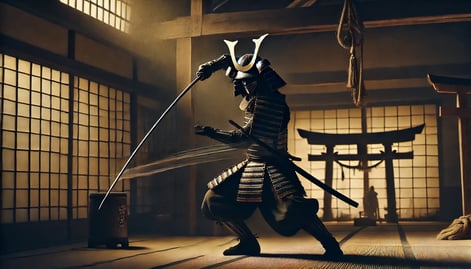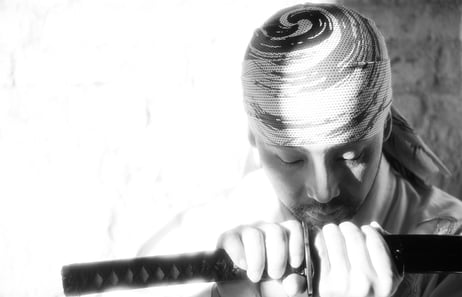🕓 2025/2/25
#文化
详细解释武士的历史和体验

目录
1. 什么是武士
武士是日本的武士阶级,从中世纪到近世纪在日本扮演着重要的军事贵族角色。最初是指贵族战士的词语,但自12世纪开始获得权力,直到1868年明治维新,这个词语开始指代统治日本政府的整个武士阶级。

武士不仅以盔甲和刀等装备著称,还以遵守武士道而闻名,武士道是武士的行为规范。然而,这个武士道直到17世纪后半期武士实际上不再参与军事活动时才被明确记录下来,那时他们更多地作为道德指导和顾问。

一些高级武士也被期望为了避免被俘而自尽。荣誉的方式是切腹,被认为是包含精神的胃部切开。武士通常穿着纯白色的衣服,从左向右切开腹部,然后由助手斩首。

2. 武士的历史
武士的历史可以追溯到奈良时代,并在平安时代到镰仓时代期间逐渐扩大了其影响力,成为日本政治和社会的核心力量。以下按时期详细解说了主要的历史事件。
1. 起源与早期发展(奈良时代 - 平安时代)
武士的起源可以追溯到奈良时代(710-794年),当时地方贵族和豪族开始组建武装部队来保护他们的土地。这被认为是武士的前身。随着平安时代(794-1185年)的到来,由于中央政府的力量减弱,地方上的武士阶级开始崛起,并逐渐掌握了更多的权力。
2. 镰仓时代与武士的崛起(12世纪 - 14世纪)
在12世纪,经过源平合战,源赖朝建立了镰仓幕府。由此,武士成为了日本政治的中心。镰仓时代(1185-1333年)是日本历史上首次建立的由武士主导的军事政权。在此期间,武士不仅掌握了军事力量,还掌控了政治权力。这个时期,剑道和武士道的理念得到了极大的强调,武士文化得到了重要的发展。
3. 室町时代的繁荣与混乱(14世纪 - 16世纪)
室町时代(1336-1573年)是一个文化繁荣和政治混乱并存的时期。武士文化在此期间进一步发展,特别是在1467年至1477年的应仁之乱之后,幕府的权力削弱,各地的战国大名开始崛起。在战国时代,武士不仅作为地方领主的武力支持,还卷入了政治权力的争斗。同时,茶道、能乐和庭园设计等文化也在这一时期得到了蓬勃发展,武士文化展现出了新的面貌。
4. 江户时代的稳定与变迁(17世纪 - 19世纪)
江户时代(1603-1868年)是德川家康统一日本后,持续约250年的和平与稳定时期。在这一时期,武士的角色从军事逐渐转变为行政和学术领域。德川幕府要求武士不仅要精通武艺,还要重视“礼学”,因此武士也承担了政治家和官僚的角色。武士遵循“武士道”的伦理指南,强调忠诚和家庭责任。然而,随着和平的持续,武士的经济地位逐渐下降,许多下级武士面临经济困境,导致他们不得不从事新的职业,如商人或工匠。
5. 明治维新与武士的终结(19世纪后期)
1868年的明治维新标志着武士时代的终结。随着日本与西方列强的接触以及内外部压力的增加,德川幕府被推翻,天皇恢复了政治实权。此次改革废除了封建制度,武士失去了他们的特权地位。政府于1876年颁布了禁止带刀令,形式上终结了武士阶级。然而,武士精神和武士道依然深深扎根于日本社会,并对日本近代化产生了巨大影响。许多前武士在政府中担任官员、教育家或商人,开辟了新的道路。武士的传统在明治之后的日本社会中依然具有影响力,并成为现代日本伦理观和价值观的基础。
3. 武士的装备
战国时代的武士装备兼具实用性和象征社会地位的元素。主要装备包括。
・日本刀 (Nihonto):
日本刀,特别是长刀(刀),对武士来说是极其重要的武器,被视为荣誉的象征。这种刀具有弯曲的单刃刀刃,能够在近战中提供速度和切割力的平衡,非常有效。日本刀的独特形状在镰仓时代得到了发展,成为武士的象征。这些刀由技艺精湛的工匠精心锻造,有时需要数周甚至数月才能完成,最终成为既美观又实用的艺术品。
・箭(Ya):
.%20The%20samurai%20is%20portrayed%20in%20full%20.png?width=460&height=263&name=DALL%C2%B7E%202023-12-25%2011.32.20%20-%20A%20dynamic%20and%20realistic%20image%20of%20a%20samurai%20in%20battle%2c%20releasing%20an%20arrow%20from%20a%20traditional%20Japanese%20longbow%20(yumi).%20The%20samurai%20is%20portrayed%20in%20full%20.png)
弓矢,特别是弓,是武士中擅长弓术者使用的武器。这种弓由竹、木和皮革制成,长度可达约2米。其独特的非对称形状使得在马背上也能高效使用,适合远距离攻击敌人。弓术不仅是武士的武器,更是精神和身体训练的一部分,后来发展成为武道中的弓道。
・枪 (Yari):
%20with%20characteristic%20features.%20The%20image%20shows%20the%20samurai%20.png?width=453&height=259&name=DALL%C2%B7E%202023-12-25%2011.32.03%20-%20A%20realistic%20depiction%20of%20a%20samurai%20from%20the%20Sengoku%20period%20wielding%20a%20yari%20(Japanese%20spear)%20with%20characteristic%20features.%20The%20image%20shows%20the%20samurai%20.png)
长枪(槍,Yari)是一种在战场上非常有效的武器,尤其适用于集体作战。长枪的长柄顶端装有锋利的刀刃,使得武士能够在保持距离的同时攻击敌人,在骑兵战中尤为有利。在战国时代,许多武士喜欢使用长枪,因为它的多用途性和高效性,使其在战场上广泛应用。
・盾 (Tate):%20to%20deflect%20arrows%20in%20battle.%20The%20shield%20is%20designed%20to%20be%20large%20enough%20to%20provid.png?width=457&height=261&name=DALL%C2%B7E%202023-12-25%2011.31.54%20-%20An%20image%20depicting%20a%20samurai%20using%20a%20traditional%20wooden%20shield%20(tate)%20to%20deflect%20arrows%20in%20battle.%20The%20shield%20is%20designed%20to%20be%20large%20enough%20to%20provid.png)
虽然盾(Tate)在武士的战斗中并不常见,但在特定的战斗场景或防御战术中有时会使用。特别是在防御堡垒或围攻战时,盾可以用来抵挡攻击。这些盾通常由木材制成,有时也会使用金属材料设计,轻便易携带。
・草摺 (Kusazuri):
.%20The%20.png?width=462&height=264&name=DALL%C2%B7E%202023-12-25%2011.31.57%20-%20A%20detailed%20image%20of%20a%20samurai%20armor%20component%20known%20as%20Kusazuri%2c%20which%20is%20a%20skirt-like%20armor%20hanging%20from%20the%20lower%20part%20of%20the%20Do%20(chest%20armor).%20The%20.png)
草摺是一种从胴甲下垂的裙状护具,主要保护下半身和大腿。这部分通常由皮革或漆涂的铁板制成,设计上兼顾了活动性和防护性。草摺的设计考虑了战场上的移动性,使武士在战斗中能够自由行动。
・胴 (Do):

胴甲是武士的主要护具,用于保护胸部和背部,在战斗中抵御致命攻击。这种护具由铁或皮革制成,有时为了抵抗火器而进行了进化。在江户时代,传统设计得到恢复,同时引入了新技术,进一步提高了胴甲的制造工艺。
・兜 (Kabuto):

兜是保护武士头部的头盔,由铆接的金属板制成。兜通常装饰有家族纹章或装饰性徽饰,用于战场上的识别和威慑。随着时间的推移,兜的设计不断演变,在战国时期变得更加复杂和装饰性更强。
这些装备随着时代战术和战斗风格的变化而不断发展,特别是随着火器的出现,装备逐渐转向板式防具。
4. 武士的等级
战国时期的武士阶级制度非常复杂,存在着多种阶级。这些阶级会根据个人的功绩、战场上的表现或家族背景而有所不同,并且在特定的战役或事件中会出现晋升或降职的情况。虽然从足轻晋升到大名的情况极为罕见,但在某些情况下,由于卓越的勇武或战术,低级阶级的武士也可能晋升到较高的阶级。
1. 将军 (Shogun): .png?width=451&height=258&name=DALL%C2%B7E%202023-12-25%2013.06.53%20-%20An%20imposing%20and%20historical%20image%20of%20Oda%20Nobunaga%2c%20a%20major%20Daimyo%20during%20Japans%20Sengoku%20period%2c%20in%20a%20castle%20setting.%20Nobunaga%20is%20depicted%20in%20full%20trad%20(1).png)
将军是武家政权的最高领导者,统领日本的军事和政治事务。将军最初是由朝廷授予“征夷大将军”称号的军事领袖,自镰仓幕府(1185-1333年)成立以来,成为武士阶级的顶点。镰仓幕府、室町幕府(1336-1573年)和江户幕府(1603-1868年)期间,将军作为日本的实际统治者,控制着各地的大名。
2. 大名 (Daimyo):
大名是地方领主,拥有广阔的土地,是仅次于将军的封建领主。大名在其领地内拥有完全的军事和经济权力,他们拥有自己的军队,统率武士来保卫领地,并管理从劳动者那里征收的税收。大名的地位通常是世袭的,随着时间的推移,其影响力逐渐增强,但在江户时代,他们的权力受到将军的制约。
3. 守护大名 (Shugo Daimyo):
守护大名原本是镰仓幕府和室町幕府时期的地方军事知事,由将军任命,负责统治多个国(地区)。然而,在15世纪后期,守护大名的权力超越了中央政府的控制,他们开始将领地视为自己的封建领土,逐渐演变为独立的大名。
4. 家老 (Karō):
家老是大名家臣团中地位最高的成员,深度参与政治和经济决策。家老作为大名的顾问,有时在大名不在或关键时刻代替大名指挥。在江户时代,许多家老负责管理地方领主的领地和行政事务,是领地管理的核心人物。
5. 侍大将 (Samurai Taisho):
侍大将是指挥大名或将军军队的武士,在军事行动的执行中起着关键作用。他们在战场上领导军队,负责战略指挥。侍大将因其勇武和指挥能力而受到高度评价,是战斗中具有重要影响力的角色。
6. 郎党 (Rōtō):
郎党是直属于大名或高级武士的家臣,主要负责军事和行政任务。他们宣誓效忠主君,从日常管理事务到战斗中的护卫,承担着各种职责。郎党作为接近主君的人物,无论战时还是平时,都履行着重要的职务。
7. 国人 (Kokujin):
国人是在中世纪日本中独立掌控小型区域的地方武士阶级。最初作为镰仓时代的地头登场,后来在室町时代和战国时代成为地方领主,建立了独立的势力。国人通常通过向农民征收的税金或收入来治理其领地,有时与外部权力(如守护大名或幕府)对抗。在战国时期,有些国人晋升为大名,而另一些则继续作为独立势力存在。
8. 地侍 (Jizamurai):
地侍是指统治地方小领主或农村的武士。他们原本是富有的农民或村庄领袖,后来在室町时代到安土桃山时代期间获得了武士的地位。地侍负责防卫其区域,战时为大名或国人效力。一部分地侍在战国时期被编入大名的家臣团,成为下级武士,但许多地侍依然留在村庄,担任村庄的领导者。
9. 足轻 (Ashigaru):
足轻是战国时期的下级士兵,主要担任步兵。他们最初是从农民或市民中征召的轻装士兵,随着战国时代的发展,逐渐演变为接受专业军事训练的职业军人。特别是在火绳枪(铁炮)引入后,足轻在战场上发挥了重要作用,成为战斗的主力部队。在江户时代,足轻的地位固定为低级武士,他们在从事农业或其他工作的同时,承担军事职责。
这些等级可以根据个人成就、战场表现或家系变动,特定战斗或事件会导致晋升或降级。虽然从足轻晋升为大名很少见,但有因卓越的武勇或战术从低级晋升至高级的例子。此外,这个等级制度深刻影响了日本的政治、经济和文化。
★ 旅游景点介绍 ★
在这篇文章中,我们将介绍精心挑选的日本旅游景点。
如果您将此网站添加为书签,您将能够了解您应该记住的旅游信息。目前正在快速更新中,将为您提供更加有趣的旅游景点寻找体验。
5. 可以体验和感受武士的地方
・京都的武士剑舞剧场:
位于京都,游客可以在这里体验传统艺术“剑舞”。由剑舞流派“正岳流”宗家钩逢贺师範运营,是学习礼仪和剑舞技术的热门景点。
・剑技群Kamui(武士道场):
这个体验项目包括学习礼仪、使用木剑的剑法、基本型10种模式的学习、摆动练习、实战场景练习等。以快乐学习真正的武士而闻名。
・东京新宿歌舞伎町的武士博物馆 :

在东京新宿歌舞伎町的武士博物馆,游客可以体验武士文化。可以实际穿着铠甲和头盔,持剑体验,特别受外国游客欢迎。
・东京的武士剧场:

位于东京神乐坂,游客可以换上武士装(和服和袴),体验剑斗和穿甲冑。此外,还可以观看强有力的表演秀,甚至可以体验使用真正的日本刀试切。
・京都的武士忍者博物馆:

在京都的这个博物馆,游客可以在乐趣中学习武士和忍者的历史,并实际体验武士和忍者。观看古老的甲冑和真正的刀后,可以穿上甲冑服装或头盔拍照。还可以穿上忍者服装体验投掷手里剑等训练。这个博物馆是接触日本历史和文化的宝贵体验,因此受到访日外国游客的欢迎
这些设施非常受外国游客欢迎,特别推荐给想要体验日本武士文化的人们。每个设施都提供了适合儿童和成人享受的项目。

%20(1).png?width=578&height=325&name=%E5%90%8D%E7%A7%B0%E6%9C%AA%E8%A8%AD%E5%AE%9A%E3%81%AE%E3%83%87%E3%82%B6%E3%82%A4%E3%83%B3%20(25)%20(1).png)

